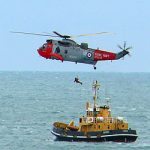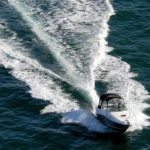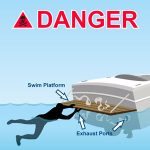Regulations require that Type B fire extinguishers be onboard where one or more of the following conditions are present:
- where there is an inboard engine
- where there is closed living space
- where there is a permanently mounted fuel tank
- where there are closed compartments for storage or portable fuel tanks
- where there is a double bottom not completely filled with foam or sealed to the hull
The number and type of fire extinguishers are determined by the boat siz and whether or not your boat has a “fixed extinguishing system”. Check the regulations and make sure that you are in compliance.
Although not required by law, a portable fire extinguisher should be mounted in an approved bracket, and the bracket mounted to the boat. Mount the extinguishers where they are readily accessible, but not immediately in the area where fires are likely to occur. For example, mounting a portable extinguisher NEAR passenger seating, the galley, and engine compartment would be prudent, but mounting a portable fire extinguisher INSIDE the engine compartment would be of little value if a fire broke out there.
If you have a fire, try and put the boat into an orientation that will place the fire downwind. If the fire is in the aft, put the bow into the wind.
When you use the portable fire extinguisher, empty it into the base of the fire from six feet away. Don’t try to use it sparingly to save some for another time. With a small boat extinguisher, you’ll have only a few seconds to try and put out the fire, so don’t be shy. Point it at the base of the fire and use it all.
The best way to handle a fire is not to let it happen in the first place. Fire needs combustible materials, heat, and oxygen to erupt or sustain itself. Keep those elements separated and you won’t have a fire to deal with. If a fire breaks out, take one of the elements away to extinguish it. Most fire extinguishers take the oxygen out of the equation.
If you can’t control the fire in short order, call for help on your radio or get the attention of another vessel quickly. Don’t wait too long to abandon ship if things get hairy, since you’re already wearing your PFD anyway…AREN’T you?
Check the nozzles on your fire extinguishers periodically. Spiders like to build entire communities in there. A strong web can divert or even block the agent from coming through the nozzle, which is an unacceptable condition if your boat is on fire. A pencil point, stick or other pointy object will remove the web easily.








